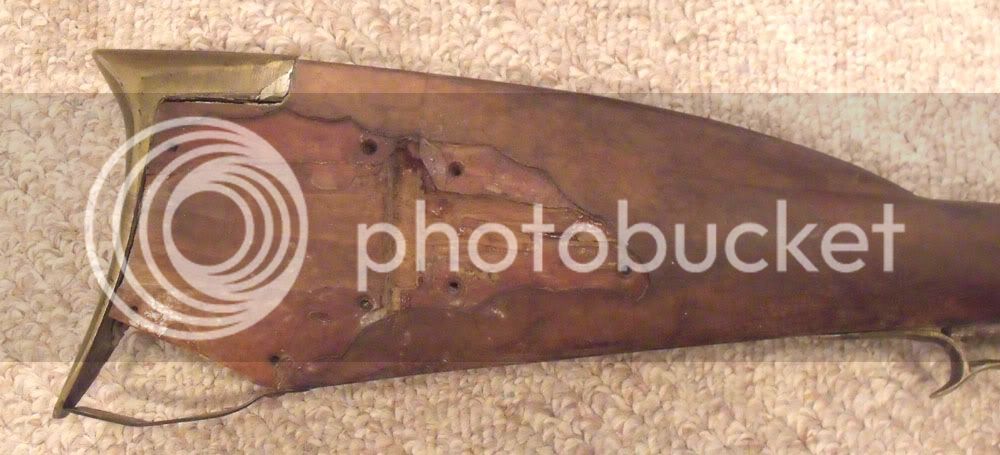Guest
Add me to the probably circa 1950 -1970 group.
I originally thought the lock was probably Numrich. I was able to locate a picture of one and it isn’t. But it is similar. There are traces of color case hardening on the lock plate. I cannot recall ever seeing this on an old rifle, but it is SOP on the later offerings from Italy, Belgium, Spain, etc.
The area around where the patchbox should be is reminiscent of the “paint spill” patchbox found on the Numrich Minuteman of the period.
The stock is stained to look like walnut but is not. My guess is maple, and it could have begun life as Dixie’s Deluxe Pennsylvania rifle stock. This stock was capable of taking up to a 40 inch barrel. Since the commonly available barrels of the time ran 42 to 44 inches this would account for the barrel sticking out past the end of the stock.
The side plates are different, but what really screams second half of the 20th century is the fact that the lock bolts appear to be zinc or nickel plated round head screws. (As an aside, I once saw a rifle that the maker was quite proud of. He had done a fairly nice job on it, but ruined the whole thing by using brass phillips head screws for everything.)
I think this rifle was made by someone just starting out who had nothing to go on but a few pictures of reproduction rifles in various black powder catalogs. He bought a precarved stock, barrel, butt plate, trigger guard, triggers, and made some things like the front sight, side plate(s) maybe the thimbles, and made an abortive attempt at a patchbox.
Further disassembly might well reveal the name Douglas or Numrich on the bottom barrel flat.
I have had the opportunity to see and even handle quite a few nice original rifles. I’ve even owned a couple.
I have also had the opportunity to handle some really awful homemade attempts at making copies of the old rifles.
This one looks like the latter.
I originally thought the lock was probably Numrich. I was able to locate a picture of one and it isn’t. But it is similar. There are traces of color case hardening on the lock plate. I cannot recall ever seeing this on an old rifle, but it is SOP on the later offerings from Italy, Belgium, Spain, etc.
The area around where the patchbox should be is reminiscent of the “paint spill” patchbox found on the Numrich Minuteman of the period.
The stock is stained to look like walnut but is not. My guess is maple, and it could have begun life as Dixie’s Deluxe Pennsylvania rifle stock. This stock was capable of taking up to a 40 inch barrel. Since the commonly available barrels of the time ran 42 to 44 inches this would account for the barrel sticking out past the end of the stock.
The side plates are different, but what really screams second half of the 20th century is the fact that the lock bolts appear to be zinc or nickel plated round head screws. (As an aside, I once saw a rifle that the maker was quite proud of. He had done a fairly nice job on it, but ruined the whole thing by using brass phillips head screws for everything.)
I think this rifle was made by someone just starting out who had nothing to go on but a few pictures of reproduction rifles in various black powder catalogs. He bought a precarved stock, barrel, butt plate, trigger guard, triggers, and made some things like the front sight, side plate(s) maybe the thimbles, and made an abortive attempt at a patchbox.
Further disassembly might well reveal the name Douglas or Numrich on the bottom barrel flat.
I have had the opportunity to see and even handle quite a few nice original rifles. I’ve even owned a couple.
I have also had the opportunity to handle some really awful homemade attempts at making copies of the old rifles.
This one looks like the latter.






